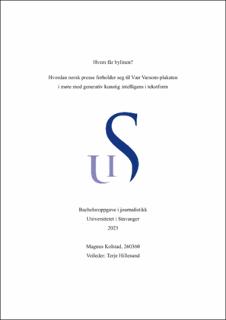| dc.contributor.advisor | Hillesund, Terje | |
| dc.contributor.author | Kolstad, Magnus | |
| dc.date.accessioned | 2023-07-13T15:51:28Z | |
| dc.date.available | 2023-07-13T15:51:28Z | |
| dc.date.issued | 2023 | |
| dc.identifier | no.uis:inspera:147841779:64580079 | |
| dc.identifier.uri | https://hdl.handle.net/11250/3078620 | |
| dc.description.abstract | Det nettbaserte programmet ChatGPT viser hvordan datamaskiner i form av chatboter kan bruke kunstig intelligens til å generere tekst ut ifra hva brukeren ber om – såkalt generativ kunstig in-telligens. ChatGPT kan ta til seg informasjon og dernest skrive en sammenhengende tekst. I til-legg kan programmet skrive ut ifra informasjon den allerede sitter på.
Denne oppgaven beskriver hvordan generativ kunstig intelligens i tekstform utfordrer Vær Var-som-plakaten med hensyn til typiske journalistiske spørsmål som ansvar og kildevern.
Oppgaven er kvalitativ og eksplorativ. Empirien består av intervjuer med fire sentrale, toneangi-vende aktører i norsk presse. De mest interessante funnene belyses tematisk og drøftes i sam-svar med den teoretiske bakgrunnen.
Oppgaven finner at informantene stort sett er åpne for å bruke teknologier som ChatGPT til enk-lere oppgaver, men at de er skeptiske til mer omfattende bruk på grunn av spørsmål knyttet til pålitelighet og kildebruk. Oppgaven finner imidlertid at informantene begrunner skepsisen til mer omfattende bruk ulikt. Videre finner oppgaven at informantene sier nei til å gi bort upubli-sert materiale til programmer som ChatGPT av hensyn til kildevern. I tillegg finner oppgaven at informantene mener saker må tydelig merkes med teknologien, selv om redaksjonen har alt an-svaret. Til slutt finner oppgaven at retningslinjer rundt teknologien først vil komme fra de enkel-te redaksjonene, ikke sentralt.
Oppgaven konkluderer med at informantene langt på vei legger Vær Varsom-plakaten til grunn for hvordan de forholder seg til tekstgererende kunstig intelligens. Samtidig viser oppgaven at informantene er mest usikre i de tilfellene VVP ikke gir tydelige svar. | |
| dc.description.abstract | The online program ChatGPT shows how computers in the form of chatbots can use artificial intelligence to generate text based on user input—so-called generative artificial intelligence. ChatGPT can absorb information and use that information to write a coherent text. The program can also write based on information it has already gathered.
This thesis describes how textual generative artificial intelligence challenges the Code of Ethics of the Norwegian Press regarding typical journalistic questions such as responsibility and source protection.
The thesis is qualitative and exploratory. The results consist of interviews with four central char-acters in the Norwegian press landscape. The most interesting results are explained thematically and discussed in accordance with the theoretical background.
The thesis finds that the informants by and large are open to use technologies such as ChatGPT for simpler tasks but hesitant with regards to more comprehensive use due to questions about reliability and sourcing. At the same time, the thesis finds that the informants justify their being hesitant about more comprehensive use differently. Furthermore, the thesis finds that the inform-ants object to giving away unpublished material to programs such as ChatGPT due to source protection. Additionally, the thesis finds that the informants think that articles must be clearly la-beled as produced by generative artificial intelligence, even though the editorial staff must as-sume all responsibility. Lastly, the thesis finds that the individual editorial offices will be the first with guidelines about generative artificial intelligence in journalism.
The thesis concludes that all the informants absolutely justify their thoughts about generative ar-tificial intelligence through the Code of Ethics of the Norwegian Press. At the same time, the thesis shows that the informants are most unsure in the cases in which the Code of Ethics doesn’t give obvious answers. | |
| dc.language | nob | |
| dc.publisher | uis | |
| dc.title | Hvem får bylinen? Hvordan norsk presse forholder seg til Vær Varsom-plakaten i møte med generativ kunstig intelligens i tekstform | |
| dc.type | Bachelor thesis | |
